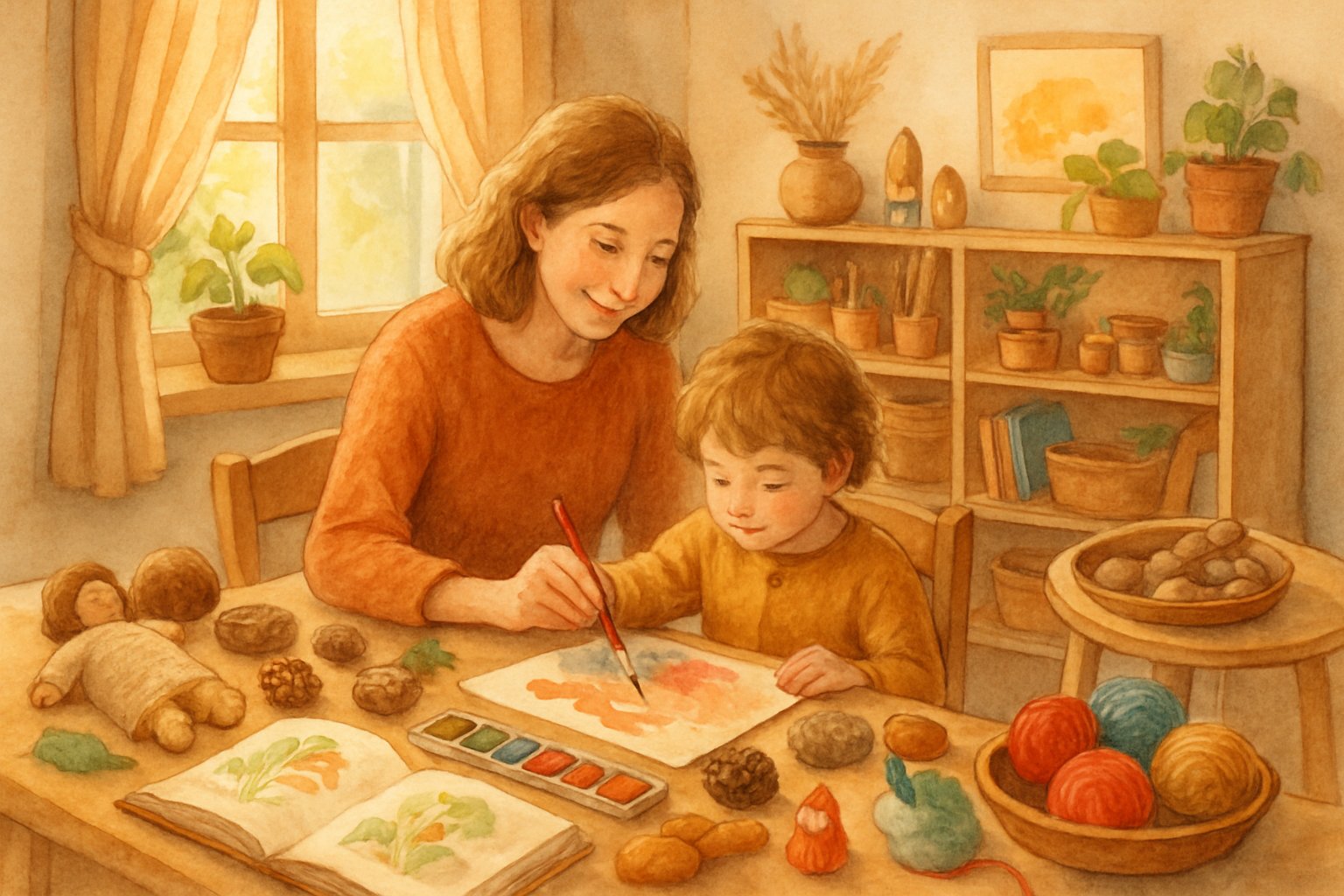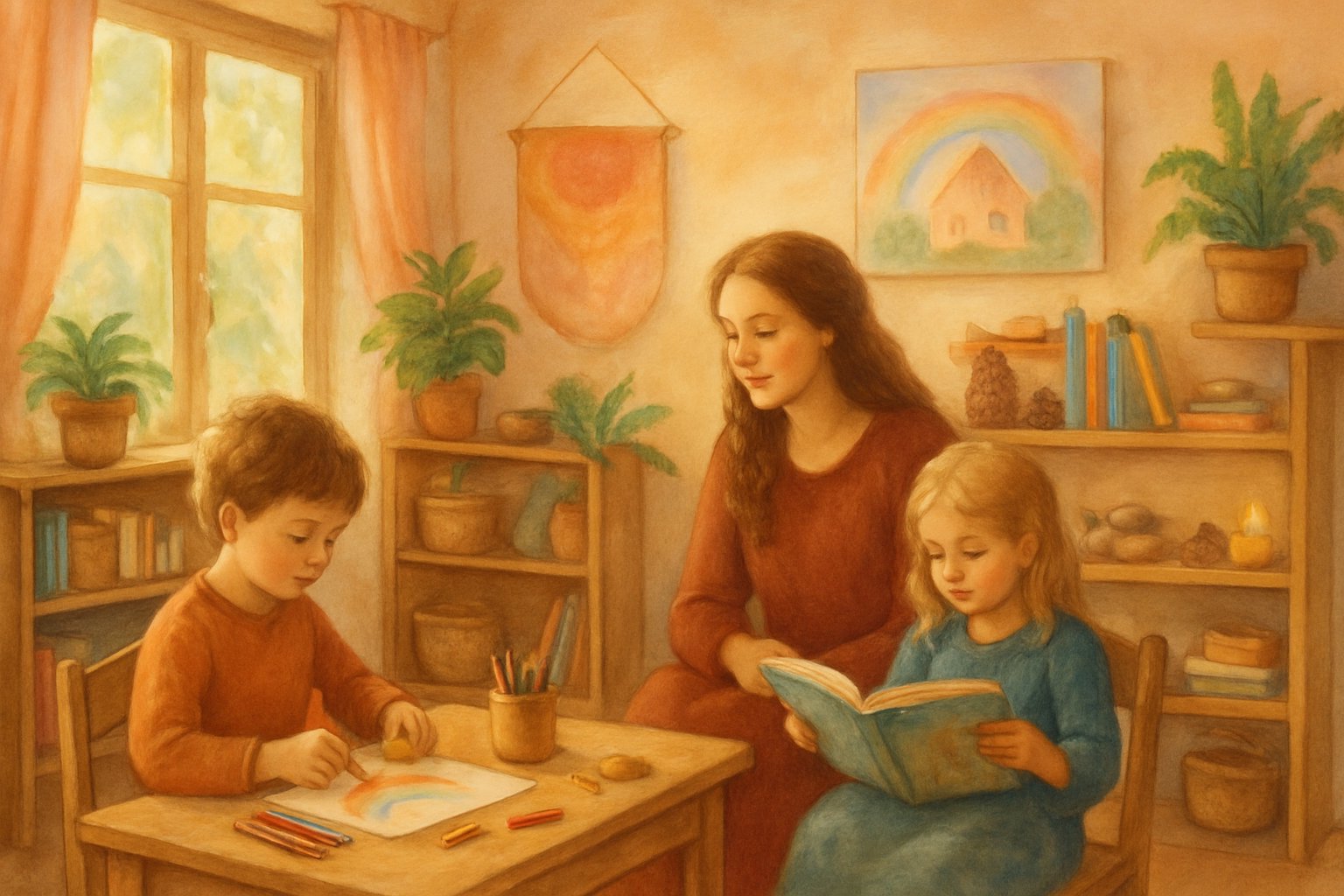Key Principles of Waldorf Homeschooling

Waldorf homeschooling centers on nurturing the whole child—mind, body, and spirit. It encourages creativity, hands-on learning, and a balanced rhythm to daily life. This approach values imagination, nature, and developmentally appropriate teaching rather than early academic pressure or heavy screen use.
Holistic Education and Child Development
The Waldorf method, founded by Rudolf Steiner, views education as a journey that unfolds in stages. Each phase of childhood has specific needs, and lessons match these stages to support balanced growth.
In early childhood, learning happens through imitation and play. During the grade years, storytelling and artistic work help children explore academic ideas in a meaningful way.
Teachers or parents who follow Waldorf education often plan lessons that engage the head, heart, and hands—thinking, feeling, and doing. This balance helps children develop intellectually, emotionally, and physically.
A Waldorf homeschool may include activities like painting, handcrafts, and movement exercises to strengthen focus and coordination. Such practices reflect the belief that education should nurture the whole person, not just academic performance.
Role of Imagination and Creativity
Imagination plays a central role in Waldorf homeschooling. Instead of relying on textbooks, parents often use stories, art, and music to spark curiosity. Lessons are presented artistically to help ideas come alive for the child.
According to Homeschooler Pro, the Waldorf method cultivates imagination and moral responsibility through creative expression. Children might paint a math concept, act out a history story, or learn science through observation and drawing.
This approach helps children connect emotionally to what they learn. It also encourages flexible thinking and problem-solving. By presenting lessons in an artistic and narrative way, parents help children see learning as joyful and meaningful rather than routine or forced.
Minimal Use of Technology
Waldorf homeschooling encourages limited use of screens, especially in early childhood. The focus stays on hands-on, sensory-rich experiences that support real-world learning.
As noted by Our Homeschool Resources, Waldorf philosophy values play, movement, and creativity over digital interaction. Children may spend more time crafting, cooking, or building rather than using computers or tablets.
This approach helps develop attention, patience, and imagination naturally. When technology is introduced later, it’s done intentionally and with purpose—usually after children have built strong foundational skills in focus and creativity.
Connection to Nature and Seasonal Rhythms
A strong connection to nature is at the heart of Waldorf education. Families often follow the rhythm of the seasons, celebrating seasonal festivals and spending time outdoors.
Activities like gardening, nature walks, and observing weather patterns help children understand the cycles of the earth. This rhythm creates a sense of stability and harmony in daily life.
According to ABCmouse, integrating art, nature, and rhythm encourages holistic development. In Waldorf homeschooling, these natural patterns guide lessons and daily routines, helping children feel grounded and connected to the world around them.
Essential Elements of the Waldorf Homeschooling Approach

Waldorf homeschooling encourages children to learn through doing, creating, and exploring. It blends academics with art, movement, and nature to support emotional, intellectual, and practical growth.
Experiential Learning and Main Lesson Blocks
In the Waldorf method of homeschooling, lessons center on experiential learning. Children learn through hands-on activities rather than memorization. This approach helps them connect ideas to real experiences.
A key feature of the Waldorf curriculum is the use of main lesson blocks, where one subject is studied deeply for several weeks. This rhythm allows students to focus fully on a topic before moving to another.
For example, a child might explore botany through gardening, sketching plants, and writing about them. This method supports understanding and retention. The Waldorf Homeschool Method emphasizes developing the “head, heart, and hands,” balancing thinking, feeling, and doing.
Storytelling and Imaginative Play
Storytelling is central to Waldorf homeschooling. Teachers and parents use folk tales, fables, and myths to introduce moral lessons and academic ideas. Listening to stories builds language, memory, and empathy.
Children often act out these stories through imaginative play, turning learning into a creative process. This kind of play fosters problem-solving skills and emotional awareness.
In the Waldorf style of learning, imagination is seen as a foundation for intellectual growth. When children imagine, they practice thinking flexibly and creatively—skills that help them approach challenges with confidence.
Creative Arts: Painting, Drawing, and Music
The creative arts form a core part of the Waldorf method of homeschooling. Subjects like painting, drawing, and music are not separate from academics—they are woven into daily lessons.
For example, students may illustrate a math concept through color and form or learn history through songs. This artistic approach, as described in Waldorf Homeschooling, nurtures creativity and helps children express understanding in personal ways.
A simple table shows how arts connect to subjects:
| Art Form | Example Integration |
|---|---|
| Painting | Depicting plant growth in science |
| Drawing | Creating geometric forms in math |
| Music | Learning rhythm through poetry recitation |
These activities engage both logic and emotion, helping children experience learning as a living process.
Movement and Outdoor Activities
Movement is essential in Waldorf homeschooling. Activities like circle games, handwork, and dance build coordination and focus. Physical rhythm supports mental rhythm, which helps children learn more easily.
Outdoor activities also play a major role. Time in nature strengthens observation skills and deepens respect for the environment. Many families use nature walks or gardening as part of their daily lessons.
According to ABCmouse’s overview of Waldorf homeschooling, learning outdoors nurtures creativity and holistic development. These experiences teach children to connect with the world around them while developing physical health and emotional balance.
Daily Life and Learning in a Waldorf Homeschool

A Waldorf homeschool day moves with a gentle rhythm that balances focused learning, creative work, and time in nature. Parents guide lessons through storytelling, art, and practical activities that connect children to real experiences instead of screens or worksheets.
Establishing Rhythm and Routine
Families using the Waldorf homeschool method often follow a daily rhythm rather than a strict schedule. This rhythm gives children a sense of security and flow throughout the day.
A typical morning might include:
- Circle time with songs and movement
- Main lesson block focusing on one subject for several weeks
- Outdoor play or nature walk after lessons
Afternoons often feature handwork, music, or art. Evenings slow down with reading or storytelling.
Each day of the week may have a theme—painting on Monday, baking on Tuesday, or gardening on Wednesday. Seasonal changes also shape the rhythm, with crafts and stories tied to nature’s cycles. This predictable flow helps children feel calm and grounded while still leaving room for creativity and exploration.
Parent as Guide and Observer
In Waldorf homeschooling, the parent acts as both teacher and learner. They guide lessons but also observe the child’s mood, interests, and growth. This approach creates a warm, trusting relationship that supports learning through connection rather than pressure.
Parents often prepare lessons ahead of time using a Waldorf curriculum but adapt them based on the child’s needs. They present new material through stories, art, or movement, allowing the child to experience concepts before analyzing them.
Observation is key. Parents notice how the child responds to rhythm, art, and play, adjusting the pace or activities accordingly. This reflective teaching style builds confidence and encourages self-directed learning.
Integrating Real-World Experiences
Waldorf homeschooling values learning through doing. Children engage in daily life tasks that connect lessons to the real world.
Examples include:
| Activity | Learning Connection |
|---|---|
| Baking bread | Fractions, patience, sensory learning |
| Gardening | Science, responsibility, observation |
| Handcrafts | Fine motor skills, focus, creativity |
Families often spend time outdoors, where nature becomes the classroom. According to Open Waldorf, integrating these experiences nurtures mindfulness and appreciation for the environment.
By blending academics with meaningful work, children see learning as part of everyday life, not something separate from it.
Leave a Reply